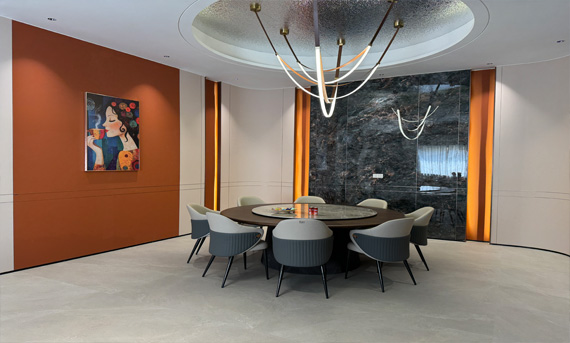Wall Panels for Hotel Private Rooms

- Fabric Wall Panels: Soften the Space, Enhance Privacy and a Sense of Warmth
In this case, fabric materials are ingeniously applied to the left of the wall, in a orange color scheme.This design creates a cozy and peaceful ambiance across the room when paired with gentle lighting. In addition to producing a gentle aesthetic, the fabric wall panels have outstanding sound-absorbing capabilities, which effectively block out outside noise and give diners a quiet and private space.
From a detailed perspective, the fabric sections utilizes a hidden seam approach to strengthen the overall coherence of the wall and prevent it from seeming fragmented.
Meanwhile, the junction between the fabric and stone-patterned panels is accented by metal trims, breaking the monotony of single materials and showcasing the meticulousness and restraint in spatial design.
- Stone-patterned Wall Panels: With a Steady Texture, They Create ADialogue between Nature and Modernity
Stone-patterned wall panels, as the foundational components of the wall surface, are laid in the middle section. They are mainly in black and gold, with natural and transparent textures. They not only embody the stability and weightiness of stone but also maintain flexibility due to the use of lightweight composite materials. The stone-patterned texture shimmers subtly under the lighting, infusing a touch of calm order into the space.In addition to improving the private room’s overall texture, this stone-textured panel has useful features like easy cleaning and moisture resistance, which satisfy the needs of commercial spaces that are used frequently. In terms of appearance, the fabric wall panels and the stone-patterned panels are positioned in a left-and-right proportional arrangement, which improves the spatial layering and guarantees a steady visual center of gravity.
- Metal Lines and Metal Plates: Embellish the Space and Highlight High-end Refinement
In this instance, the design highlights that cannot be disregarded are metal components. Their use accurately communicates the space’s upscale stance without being unduly flashy or forceful. Narrow metal lines define distinct boundaries at the wall-ceiling connections, light-strip joints, and wall panel seams, adding to the overall tidy appearance.
In order to achieve a straightforward yet eye-catching top design, the ceiling is also covered with unique metal plates and a pendant light with a light strip system. By reflecting gentle light and avoiding light pollution, matte metal gives the room a sense of depth and beauty. This careful metal treatment shows a great deal of control over material application in high-end dining spaces.
- Harmony of Overall Lighting and Materials: Craftinglayers and atmosphere
In terms of lighting design, the combination of linear light strips and recessed downlights draws attention to the ceiling’s geometric beauty while unintentionally highlighting the differences in stone and metal texture. The lighting’s color temperature, which is set at about 3000K, blends in flawlessly with the fabric’s soft gray tones, giving the room a contemporary yet cozy feel.
Rich light-shade variations are produced by the light on various reflecting surfaces in the meantime. Together, the light absorption of the fabric, the diffuse reflection of the stone grain, and the micro-reflection of the metal produce a dynamic visual hierarchy that heightens the drama and immersion of the room while providing diners with a singular sensory experience.
- Design Summary
Dialogue between Materials, Forging the Spatial Temperament
Through the reasonable combination and zoned application of three materials – fabric, stone textures and metal – this case perfectly interprets the four key elements that a modern high-end hotel private room should possess: comfort, privacy, texture and style. Each material not only complements the others visually, but also enhances functionality and user experience.
This ultimate pursuit of details not only reflects the designer’s precise interpretation of the language of materials, but also demonstrates the hotel brand’s deep concern for the customer experience. In today’s increasingly fierce competition in high-end dining Spaces, such a space design that takes into account both aesthetics and practicality will undoubtedly become an crucial advantage to attract customers and enhance brand value.

